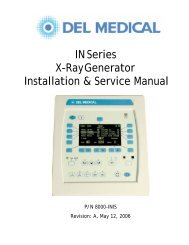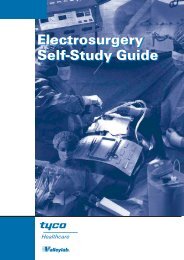A Framework of Medical Equipment Management System for In ...
A Framework of Medical Equipment Management System for In ...
A Framework of Medical Equipment Management System for In ...
Create successful ePaper yourself
Turn your PDF publications into a flip-book with our unique Google optimized e-Paper software.
A. The system network architecture<br />
The system network architecture (Fig. 1) was designed<br />
under the consideration <strong>of</strong> data safety and work per<strong>for</strong>mance.<br />
This was divided into three parts. First, the intranet in hospital<br />
connects the overall operating computers <strong>of</strong> hospital and the<br />
hospital in<strong>for</strong>mation system (HIS). HIS sends some basic<br />
in<strong>for</strong>mation <strong>of</strong> medical equipment (such as budget, purchase,<br />
and property in<strong>for</strong>mation) to the MEMS. The inner users can<br />
also access MEMS through the intranet. Second, the MEMS<br />
was set up in the intranet <strong>of</strong> CED and connected to the<br />
intranet <strong>of</strong> the hospital through a router. The architecture will<br />
increase the work per<strong>for</strong>mance <strong>for</strong> the inner users <strong>of</strong> CED in<br />
input or query data to MEMS and system maintenance. <strong>In</strong><br />
addition to MEMS, the local network also includes a Web<br />
server <strong>of</strong> CED and a database. Third, the Web server <strong>of</strong> CED<br />
connects to the internet through a firewall and provides a<br />
service <strong>for</strong> supporting outside branch member to access the<br />
database <strong>of</strong> CED, which shares related in<strong>for</strong>mation like the<br />
procurement, maintenance, and contract related.<br />
Fig. 2. Relationship between the modules <strong>of</strong> the medical equipment<br />
management system.<br />
B. The medical equipment management system architecture<br />
The MEMS, the main elements is shown in Fig. 2, which<br />
contains ten sub-systems, i.e. the basic in<strong>for</strong>mation,<br />
procurement, acceptance, discard, maintenance, installation<br />
verification, warranty inspection, prevent maintenance, and<br />
contract management. These systems were designed<br />
according to the operational activity <strong>of</strong> CED. On the basis <strong>of</strong><br />
different operating attribution, they can be classified into four<br />
groups.<br />
The first group is the basic in<strong>for</strong>mation, which primarily<br />
provides fixed in<strong>for</strong>mation to other sub-systems such as<br />
inventory in<strong>for</strong>mation, staff data, equipment maintenance<br />
vendors, user department and their cost center code. These<br />
data comes from HIS and automatically updates. When a user<br />
operates other sub-system and inputs a key word, this related<br />
basic in<strong>for</strong>mation will be loaded to an appropriate field. The<br />
mechanic will reduce the user operating time and increase the<br />
data correctness.<br />
The second group contains the procurement, acceptance,<br />
and discard practices. These practices focus on document<br />
6055<br />
assessment. There<strong>for</strong>e, the timing record is crucial to the<br />
daily work activities <strong>of</strong> engineer in CED. Biomedical<br />
managers must be able to correctly assign staffs <strong>for</strong> the right<br />
job and to monitor the rate <strong>of</strong> progress. The administrative<br />
staff needs to record the right date and time at different<br />
conditions such as receipting, dispatching, inspecting, and<br />
closing in service case. Besides, the date and time data will be<br />
automatically reloaded by the system when a user inputs the<br />
case number. Moreover, the engineer needs to key in the<br />
assessing results to the system. The history in<strong>for</strong>mation <strong>of</strong><br />
related equipment could also be queried by these sub-systems.<br />
The maintenance function is used <strong>for</strong> amending the error data<br />
and provides managing authorization <strong>for</strong> a specific user.<br />
The third group is mainly aimed at medical equipment<br />
maintenance and the repair work <strong>of</strong> CED, which is the busiest<br />
in MEMS <strong>for</strong> daily work. <strong>In</strong> NTUH, the repair cases were<br />
around eighty thousand per year. Its users include clinical<br />
staffs <strong>of</strong> the hospital and administrators and biomedical<br />
engineers (BME) in CED. To clinical staffs, its function is<br />
like an order work system when the equipment has a<br />
breakdown. Besides, it also provides user tracing the progress<br />
and content <strong>of</strong> maintenance or repair. For administrators in<br />
CED, their major works focus on inputting the time to the<br />
system when the repair case is in the key point such as receipt,<br />
dispatch, user retrieve, and close moment. For engineers in<br />
CED, they input the repair content, delay reasons, and the<br />
finished time <strong>of</strong> ending repair. Besides, the biomedical<br />
mangers can query related statistics from the sub-system to<br />
obtain per<strong>for</strong>mance indicators, to determine equipment<br />
failure trends, to identify training needs, and to produce<br />
management reports.<br />
The final group includes warranty, maintenance, and<br />
contract management systems. The attribution <strong>of</strong> the group<br />
belongs to managing activities which have the property <strong>of</strong><br />
period plan in advance. So, the system can send a notice to an<br />
engineer according to the important time point <strong>of</strong><br />
predetermined schedule such as warranty expired, executing<br />
prevent maintenance, or carrying out the contract service.<br />
This in<strong>for</strong>mation can be triggered by BME to print a work<br />
order. Besides, the BME can also set and manage related<br />
equipment list and time schedule. The query function shows a<br />
list <strong>of</strong> requesting work orders in the certain period. All the<br />
content <strong>of</strong> per<strong>for</strong>mance in the group will be integrated with<br />
the general maintenance <strong>of</strong> data. To query by inventory<br />
number, the user can easily get related in<strong>for</strong>mation with<br />
different maintenance stratagems <strong>for</strong> certain equipment.<br />
Finally, the maintenance statistic function provides<br />
biomedical managers the in<strong>for</strong>mation about the per<strong>for</strong>mance<br />
<strong>of</strong> BME and outsourcing.<br />
C. Developing tools<br />
The developing tools are used <strong>for</strong> web page design and<br />
database building. First, the web pages <strong>of</strong> MEMS were<br />
designed by the Visual studio C# and the web server <strong>of</strong> CED<br />
by the FrontPage and Dreamweaver, because the s<strong>of</strong>tware is<br />
easy to get and easy to use. The C# was adopted by the IT










